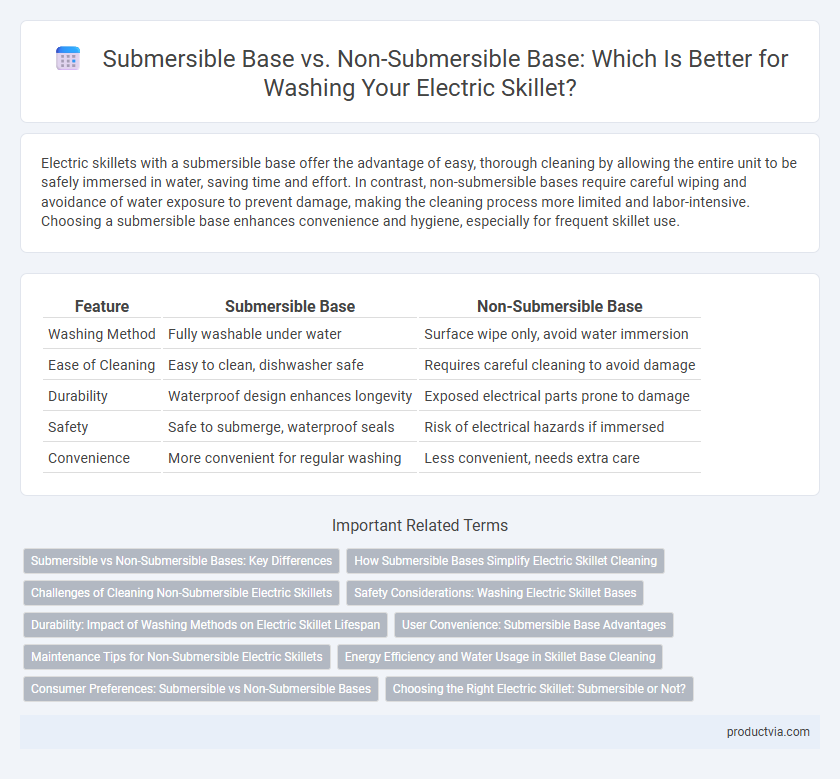Electric skillets with a submersible base offer the advantage of easy, thorough cleaning by allowing the entire unit to be safely immersed in water, saving time and effort. In contrast, non-submersible bases require careful wiping and avoidance of water exposure to prevent damage, making the cleaning process more limited and labor-intensive. Choosing a submersible base enhances convenience and hygiene, especially for frequent skillet use.
Table of Comparison
| Feature | Submersible Base | Non-Submersible Base |
|---|---|---|
| Washing Method | Fully washable under water | Surface wipe only, avoid water immersion |
| Ease of Cleaning | Easy to clean, dishwasher safe | Requires careful cleaning to avoid damage |
| Durability | Waterproof design enhances longevity | Exposed electrical parts prone to damage |
| Safety | Safe to submerge, waterproof seals | Risk of electrical hazards if immersed |
| Convenience | More convenient for regular washing | Less convenient, needs extra care |
Submersible vs Non-Submersible Bases: Key Differences
Submersible bases in electric skillets allow the entire unit, including the heating element, to be safely immersed in water for thorough cleaning, reducing buildup and grease residue. Non-submersible bases require detaching the heating element before washing to prevent water damage, making cleaning more time-consuming and potentially less effective. Choosing between submersible and non-submersible bases depends on convenience preferences and maintenance frequency, with submersible models offering greater ease of cleaning.
How Submersible Bases Simplify Electric Skillet Cleaning
Submersible bases allow electric skillets to be fully immersed in water, making it easier to clean stubborn food residues without risking damage to electrical components. This design eliminates the need for complicated wiping techniques and reduces the time spent scrubbing, enhancing overall convenience. Non-submersible bases require careful cleaning around electrical parts, often necessitating additional tools and effort to maintain hygiene.
Challenges of Cleaning Non-Submersible Electric Skillets
Non-submersible electric skillets present significant cleaning challenges due to their fixed electrical components, which prevent immersion in water and limit thorough washing. Residue and grease often accumulate around the heating elements and base, requiring careful spot cleaning and the use of damp cloths or specialized cleaning tools to avoid water damage. This design increases the risk of incomplete sanitation and potential buildup of bacteria if not meticulously maintained after each use.
Safety Considerations: Washing Electric Skillet Bases
Submersible bases of electric skillets allow safe immersion in water for cleaning, reducing the risk of electrical damage and ensuring thorough sanitation. Non-submersible bases require careful wiping with a damp cloth to avoid water entering electrical components, preventing potential short circuits or electric shocks. Prioritizing manufacturer guidelines ensures optimal safety and longevity of the electric skillet during washing.
Durability: Impact of Washing Methods on Electric Skillet Lifespan
Electric skillets with non-submersible bases require careful cleaning to prevent water damage to electrical components, which can compromise durability over time. Submersible base models allow full immersion during washing, reducing the risk of residue buildup and enhancing long-term performance and lifespan. Choosing a submersible base electric skillet generally offers greater durability due to easier maintenance and reduced exposure to corrosion from improper cleaning.
User Convenience: Submersible Base Advantages
A submersible base in an electric skillet offers superior user convenience by allowing the entire unit, including the heating element, to be safely immersed in water for thorough cleaning. This design eliminates the need to wipe around the base or avoid water contact, significantly reducing cleaning time and effort. Users benefit from a hassle-free maintenance routine, ensuring hygiene without risking damage to electrical components.
Maintenance Tips for Non-Submersible Electric Skillets
Non-submersible electric skillets require careful cleaning to avoid damaging the electrical components, making hand-wiping the skillet with a damp cloth the best maintenance practice. Avoid immersing the entire unit in water; instead, detach the heating element if possible and wipe it separately with a dry or slightly damp cloth. Regularly check for food residue buildup around the base and clean promptly to maintain optimal performance and extend the skillet's lifespan.
Energy Efficiency and Water Usage in Skillet Base Cleaning
Electric skillets with submersible bases allow for thorough cleaning without risking damage to electrical components, generally reducing water usage by enabling soak cleaning. Non-submersible bases require careful wiping and limited water exposure, often leading to increased use of cleaning agents and repeated rinsing, which can elevate water consumption and energy use in drying. Choosing a submersible base model enhances energy efficiency by minimizing the need for extended drying times and reduces overall water consumption during skillet base maintenance.
Consumer Preferences: Submersible vs Non-Submersible Bases
Consumers often prefer electric skillets with submersible bases for their ease of cleaning and convenience, allowing the entire unit to be safely immersed in water. Submersible bases reduce the hassle of wiping and scrubbing around electrical components, making maintenance simpler and quicker. However, some opt for non-submersible bases due to perceived durability and the possibility of longer lifespan by avoiding water exposure to the heating element.
Choosing the Right Electric Skillet: Submersible or Not?
Choosing between a submersible and non-submersible base for an electric skillet hinges on cleaning convenience and safety. Submersible bases allow the entire skillet to be washed under water without damaging the electrical components, providing ease of maintenance and thorough cleaning. Non-submersible bases require careful wiping and spot cleaning to avoid water contact with the electrical parts, making them less convenient but often more durable for heavy-duty cooking.
Submersible base vs Non-submersible base for electric skillet washing Infographic

 productvia.com
productvia.com